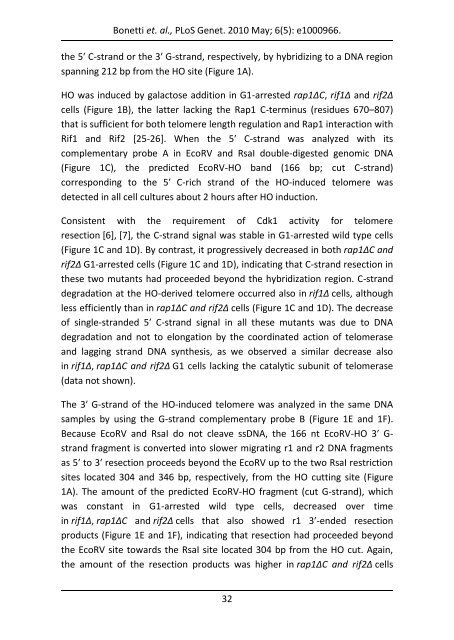View/Open - Università degli Studi di Milano-Bicocca
View/Open - Università degli Studi di Milano-Bicocca
View/Open - Università degli Studi di Milano-Bicocca
Create successful ePaper yourself
Turn your PDF publications into a flip-book with our unique Google optimized e-Paper software.
Bonetti et. al., PLoS Genet. 2010 May; 6(5): e1000966.<br />
the 5′ C-strand or the 3′ G-strand, respectively, by hybri<strong>di</strong>zing to a DNA region<br />
spanning 212 bp from the HO site (Figure 1A).<br />
HO was induced by galactose ad<strong>di</strong>tion in G1-arrested rap1ΔC, rif1Δ and rif2Δ<br />
cells (Figure 1B), the latter lacking the Rap1 C-terminus (residues 670–807)<br />
that is sufficient for both telomere length regulation and Rap1 interaction with<br />
Rif1 and Rif2 [25-26]. When the 5′ C-strand was analyzed with its<br />
complementary probe A in EcoRV and RsaI double-<strong>di</strong>gested genomic DNA<br />
(Figure 1C), the pre<strong>di</strong>cted EcoRV-HO band (166 bp; cut C-strand)<br />
correspon<strong>di</strong>ng to the 5′ C-rich strand of the HO-induced telomere was<br />
detected in all cell cultures about 2 hours after HO induction.<br />
Consistent with the requirement of Cdk1 activity for telomere<br />
resection [6], [7], the C-strand signal was stable in G1-arrested wild type cells<br />
(Figure 1C and 1D). By contrast, it progressively decreased in both rap1ΔC and<br />
rif2Δ G1-arrested cells (Figure 1C and 1D), in<strong>di</strong>cating that C-strand resection in<br />
these two mutants had proceeded beyond the hybri<strong>di</strong>zation region. C-strand<br />
degradation at the HO-derived telomere occurred also in rif1Δ cells, although<br />
less efficiently than in rap1ΔC and rif2Δ cells (Figure 1C and 1D). The decrease<br />
of single-stranded 5′ C-strand signal in all these mutants was due to DNA<br />
degradation and not to elongation by the coor<strong>di</strong>nated action of telomerase<br />
and lagging strand DNA synthesis, as we observed a similar decrease also<br />
in rif1Δ, rap1ΔC and rif2Δ G1 cells lacking the catalytic subunit of telomerase<br />
(data not shown).<br />
The 3′ G-strand of the HO-induced telomere was analyzed in the same DNA<br />
samples by using the G-strand complementary probe B (Figure 1E and 1F).<br />
Because EcoRV and RsaI do not cleave ssDNA, the 166 nt EcoRV-HO 3′ Gstrand<br />
fragment is converted into slower migrating r1 and r2 DNA fragments<br />
as 5′ to 3′ resection proceeds beyond the EcoRV up to the two RsaI restriction<br />
sites located 304 and 346 bp, respectively, from the HO cutting site (Figure<br />
1A). The amount of the pre<strong>di</strong>cted EcoRV-HO fragment (cut G-strand), which<br />
was constant in G1-arrested wild type cells, decreased over time<br />
in rif1Δ, rap1ΔC and rif2Δ cells that also showed r1 3′-ended resection<br />
products (Figure 1E and 1F), in<strong>di</strong>cating that resection had proceeded beyond<br />
the EcoRV site towards the RsaI site located 304 bp from the HO cut. Again,<br />
the amount of the resection products was higher in rap1ΔC and rif2Δ cells<br />
32

















